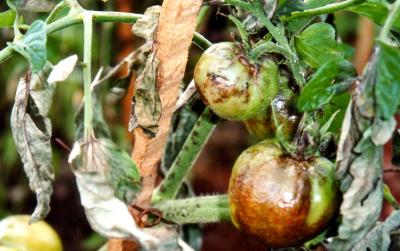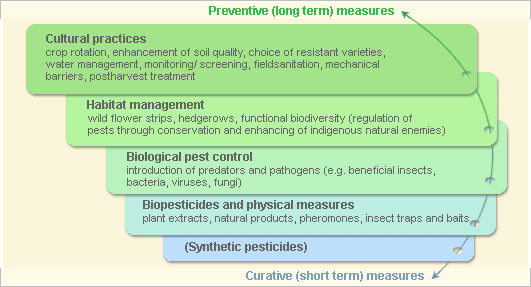Geographical Distribution in Africa
Geographical Distribution of Late blight in Africa (red marked). Updated on 11th July 2019. Source CABI.
General Information on Disease and Damage
Host range
Late blight is a fungal disease that can affect many vegetables of the Solanum species, mainly potatoes and tomatoes, but also eggplants. Late blight of potatoes or tomatoes can be devastating with dramatic and disastrous economic consequences. It is known as the most devastating disease of potatoes.
When conditions favour development of late blight and there are no steps taken to suppress the disease, it can completely destroy the above-ground parts of plants (stems, leaves, tomato fruits) and can also affect potato tubers.
Symptoms
Late blight symptoms can develop on leaves, stems, branches, and in case of tomatoes on both green and ripe fruits. In potatoes, tubers can also be infected. On leaves, pale green to brown spots, sometimes with a purplish tinge, appear on the upper surface of leaves. Leaf spot margins often are pale green or water-soaked. The spots may enlarge rapidly until entire leaflets are killed. In moist conditions, a downy white greyish mould usually develops near the margin of leaf spots on the underside of leaves. In dry weather, affected foliar parts may appear dry and shrivelled. Stems can also develop elongated, greyish watery brown lesions.
 |
| Late blight on tomatoes. Note scorched appearance of leaves, stems and fruits. |
| © B. Loehr, icipe |
On tomato fruit, grey green watery spots can develop on the upper half of the fruit, which later spread and turn greasy brown and bumpy. In moist weather, a white downy fungal growth may appear on the affected fruit-rot surface. Infected potato tubers exhibit wet and dry rots.
Late blight symptoms can be mistaken for several other diseases. Late blight is sometimes confused with early blight (Alternaria solani). Early blight symptoms are more circular, larger and darker than late blight marking and have a definite concentric (zonate) margins. Active late blight spots are not zonate and typically do not have definite concentric rings.
Patches of infected plants have a characteristic odour as a result of the rapid breakdown of plant material.
Affected plant stages
All stages.
All parts.
Symptoms by affected plant part
Fruits: spots, unusual odour
Leaves: spots; abnormal colours; wilting; fungal growth.
Vegetative organs: leaf necrosis, dry rot.
Whole plant: seedling blight; leaf necrosis
Biology and Ecology of Late Blight
The late blight fungus survives in infected potato tubers in the ground or in cull piles and in infected tomato fruits and crop debris. The fungus can also survive in perennial weeds, such as nightshade. As infected tubers and perennial weeds germinate and grow, the fungus becomes active and reproduces on the young plants.
Disease transmission
Spores are the mechanism for the rapid and devastating spread of late blight when conditions are cool and moist. Splashes of water can transfer the spores from plant to plant and wind can carry the spores greater distances. If Irish potatoes have been grown in a field, infected tubers remaining in the soil after harvest can be a source of the disease for crops that follow.
Pest and Disease Management
Pest and disease management: General illustration of the concept of Infonet-biovision

This illustration shows the methods promoted on infonet-biovision. The methods shown at the top have a long-term effect, while methods shown at the bottom have a short-term effect. In organic farming systems, methods with a long-term effect are the basis of crop production and should be of preference. On the other hand methods with a short-term effect should be used in emergencies only. On infonet we do not promote synthetic pesticides.
Further below you find concrete preventive and curative methods against Late blight.
Cultural practices
Further cultural measures are:
Use healthy seeds / planting material
Use only tomato seeds / transplants and potato tubers that are certified disease free. Growing healthy plants helps to prevent disease in crops. It is recommended to adding compost or well decomposed animal manure, and to sow green manures help to improve soil structure and nutrient content to produce a healthier crop that can tolerate / or resist blight.
Field sanitation
Eliminate all early disease inoculum by destroying crop residues such as potato cull piles and tomato debris, prevent growth of volunteer potatoes, and planting tomatoes as far as possible from potatoes. Remove crop residues after harvesting.
Crop rotation
Rotation away from tomatoes and potatoes for 3 to 4 years helps to break the disease cycle. Do not plant potato near tomato or other solanaceous crops when disease has occurred, as the disease can easily spread from one to the other. Rotation will only be effective if it is done in cooperation with neighbouring farmers since the fungal spores of late blight can wind travel quite large distances.
Proper plant spacing
Allow proper aeration among the plants and proper sunlight penetration. Indeterminate tomato varieties should be pruned and staked. Ask for assistance from your local agriculture office.
Resistant varieties
In some agro-ecosystems, cultivars with tolerance are available and these could significantly reduce late blight damage. In Kenya the potato varieties 'Asante' (red) and 'Tigoni' (white) are fairly resistant to late blight. CIP (The International Potato Centre) is testing other resistant potato varieties in the region, expecting to release more resistant varieties in the future. ICIPE is testing tomato varieties for resistance to late blight (Dr. A.A. Seif, personal communication). Ask your agricultural extensionist for information on recommended varieties for your locality.
In Tanzania, the following commercial tomato varieties have been claimed to have some be resistance to late blight: "Meru", "Tengeru 97" and "Shengena".
Tool hygiene
Clean tools thoroughly before using in a different area of crops to stop the disease spreading. It is advisable to start field operations in clean fields and end-up in diseased fields. This would reduce spread of the disease in the farm.
Solarisation
High temperatures have been used to control Phytophthora in many ways. Steam heat to kill Phytophthora in contaminated soil in greenhouses was used many years ago in the developed / first world countries. Although the industry now uses soil-less media, homeowners can still use this technique. Solar heating in the field by laying out clear polyethylene tarps helps pasteurise the soil. This method has been useful in places with a large proportion of cloudless days. For further information on solarisation click here.
Weather forecasts
Listen to weather forecasts on the possible late blight outbreaks (where such forecasts are broadcasted) or ask for updates from your local agriculturists. The temperature-humidity rule is one of the methods used to forecast the late blight epidemic. Late blight fungus will sporulate (produce spores) when there is a cool and warm temperature that is not less than 10° C, and the relative humidity is over 75% and lasts for 2 consecutive days.
Potato: use healthy seed tubers
Late blight has not been reported as seed-borne on true seeds of potato. However, it is seed-borne on tuber seed pieces. For potatoes, it is therefore important to plant certified disease-free tubers.
How to select healthy potato tubers
First plant parts to be inspected should be the seed tubers. Lesions can be readily seen on clean tubers with smooth white skins. Lesions are more difficult to detect on russeted or pigmented tubers. External inspection should be followed by observation of the flesh just underneath the potato tuber skin. Late blight causes a corky, 'granular', apparently discontinuous dry rot. Do not use these potato tubers for propagation.
If you are not sure whether you have a healthy potato there is a small test:
Take potato tubers out in the field or keep in a warm place for about 15 - 20 days before planting. Let them sprout at a temperature of 15 - 20º C for 10 - 15 days. Diseased potato tubers will rot in high temperatures. Remove the rotten ones and dispose them, and select the healthy sprouted potatoes as planting materials.
Planting potato
Good soil coverage provides better protection for the potato tubers. Sow tubers in holes more than 15 cm deep to protect them from easy infection. Hilling up the plant rows after germination will also reduce tuber infestation.
Post-harvest treatment of potato tubers
Before harvesting potatoes, the tops should be cut and left to dry completely. Harvest potato when the vines are completely dead because the causal agent of blight will not survive in dead vegetation. Dry tubers and remove infected ones before storing to reduce additional losses from soft rot diseases.
Tomato: seed-treatment
For more information on hot -water treatment of seeds click here.
Farmers experiences - avoiding crop losses
1. Farmers in the Andes plant susceptible potatoes at high altitudes where low temperatures and low moisture reduce late blight pressure. However, this strategy is frequently used in such a way that farmers trade off yield potential for decreased risk of disease. One survey in Ecuador estimated that between 30 and 40% of potato production in a province in central Ecuador was done in the dry season to avoid late blight. Yields in the dry season are considerably lower.
2. Similarly, much of the potato production in the highlands of Ethiopia occurs during a period known as the "short rains". Yields are low during this period because of limited water supply, but the risk of losses due to blight is also reduced. Overall production in this country could be increased by the introduction of potato cultivars with tolerance/ resistance to late blight that could be planted in the main rainy season.
3. Traditional farmers in Kenya use a mixture of Mexican marigold, nettle and Piectranthus barbatus (beautiful blue flowered shrub commonly used for hedging and said to have particular fungicidal properties) (Kikuyu name:Maigoya) to prevent outbreaks of late blight.
Biopesticides and physical methods
Copper
In wet weather fungicide sprays should be applied as soon as the disease is observed or as soon as local experience suggests that weather conditions are favourable for disease development.
Crop scouting should be used as a guide in making a decision on whether to apply a fungicide. And when applying fungicides, safety procedures in application must be complied with, particularly, in use of protective clothing. Observe right dosage and prescribed pre-harvest intervals. Ask your local agricultural extensionist on locally registered fungicides.
For further information see also standard procedures for application of copper click here.
Information Source Links
- CABI (2004). Crop Protection Compendium, 2004 Edition. © CAB International Publishing. Wallingford, UK. www.cabi.org
- CIP - International Potato Centre. P.O.Box25171, Nairobi 00603, Kenya. www.cipotato.org
- GILB. Global Late Blight Initiative. http://gilb.cip.cgiar.org/
- HDRA. Henry Doubleday Research Association, UK. www.gardenorganic.org.uk
- Kuepper, G. and Sullivan, P. (2004). Organic Alternatives for Late Blight Control in Potatoes. Pest Management Technical Note. ATTRA.https://attra.ncat.org
- Oisat. Online Information Service for Non-Chemical Pest Management in the Tropics. www.oisat.org
- Pscheidt, J. Diagnosis and control of Phytophthora diseases. An online guide to plant disease control. Oregon State University Extension.www.pnwhandbooks.org
- University of Minnesota. Late blight of tomato and potato. www.extension.umn.edu
- Varela, A.M, Seif, A.A. and Löhr, B. (2003). A Guide to IPM in Tomato Production in Eastern and Southern Africa. pp. 144. ICIPE Science Press, Nairobi, Kenya. ISBN: 92 9064 149 5
